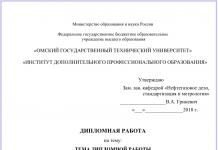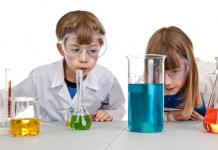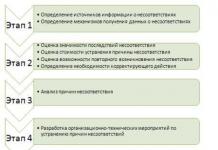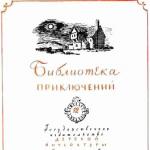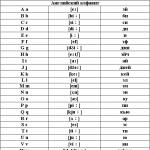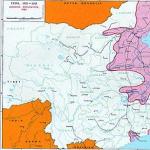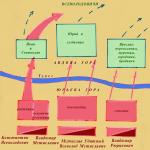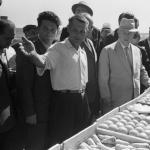The main question that a person must know the answer to in order to correctly understand the picture of the world is what a substance is in chemistry. This concept is formed at school age and guides the child in further development. When starting to study chemistry, it is important to find points of contact with it at the everyday level; this allows you to clearly and clearly explain certain processes, definitions, properties, etc.
Unfortunately, due to the imperfection of the education system, many people miss some fundamental basics. The concept of “substance in chemistry” is a kind of cornerstone; timely mastery of this definition gives a person the right start in subsequent development in the field of natural science.
Formation of the concept
Before moving on to the concept of substance, it is necessary to define what the subject of chemistry is. Substances are what chemistry directly studies, their mutual transformations, structure and properties. In the general understanding, matter is what physical bodies are made of.
So, in chemistry? Let us form a definition by moving from a general concept to a purely chemical one. A substance is something that necessarily has mass that can be measured. This characteristic distinguishes matter from another type of matter - a field that has no mass (electric, magnetic, biofield, etc.). Matter, in turn, is what we and everything that surrounds us are made of.
A slightly different characteristic of matter, which determines what exactly it consists of, is already a subject of chemistry. Substances are formed by atoms and molecules (some by ions), which means that any substance consisting of these formula units is a substance.
Simple and complex substances
After mastering the basic definition, you can move on to complicate it. Substances come in different levels of organization, that is, simple and complex (or compounds) - this is the very first division into classes of substances; chemistry has many subsequent divisions, detailed and more complex. This classification, unlike many others, has strictly defined boundaries; each compound can be clearly attributed to one of the types, which are mutually exclusive.

A simple substance in chemistry is a compound consisting of atoms of only one element from the periodic table. As a rule, these are binary molecules, that is, consisting of two particles connected through a covalent non-polar bond - the formation of a common lone pair of electrons. Thus, atoms of the same chemical element have identical electronegativity, that is, the ability to hold a common electron density, so it is not biased towards any of the bond participants. Examples of simple substances (non-metals) are hydrogen and oxygen, chlorine, iodine, fluorine, nitrogen, sulfur, etc. The molecule of a substance such as ozone consists of three atoms, and all noble gases (argon, xenon, helium, etc.) are made of one. Metals (magnesium, calcium, copper, etc.) have their own type of bond - metallic, which occurs due to the socialization of free electrons inside the metal, and the formation of molecules as such is not observed. When writing a metal substance, simply indicate the symbol of the chemical element without any indices.
A simple substance in chemistry, examples of which were given above, differs from a complex substance in its qualitative composition. Chemical compounds are formed by atoms of different elements, from two or more. In such substances, a covalent polar or ionic type of binding takes place. Since different atoms have different electronegativity, when a common electron pair is formed, it shifts towards a more electronegative element, which leads to a general polarization of the molecule. The ionic type is an extreme case of the polar type, when a pair of electrons is completely transferred to one of the bonding participants, then the atoms (or their groups) turn into ions. There is no clear boundary between these types; the ionic bond can be interpreted as a highly polar covalent bond. Examples of complex substances are water, sand, glass, salts, oxides, etc.

Modifications of substances
Substances called simple actually have a unique feature that is not inherent in complex ones. Some chemical elements can form several forms of a simple substance. The basis is still one element, but the quantitative composition, structure and properties radically distinguish such formations. This feature is called allotropy.
Oxygen, sulfur, carbon and other elements have several For oxygen - these are O 2 and O 3, carbon gives four types of substances - carbine, diamond, graphite and fullerenes, the sulfur molecule can be orthorhombic, monoclinic and plastic modification. Such a simple substance in chemistry, examples of which are not limited to those listed above, is of great importance. In particular, fullerenes are used as semiconductors in technology, photoresistors, additives for the growth of diamond films and for other purposes, and in medicine they are powerful antioxidants.
What happens to the substances?
Every second there is a transformation of substances inside and around. Chemistry examines and explains those processes that involve a qualitative and/or quantitative change in the composition of reacting molecules. In parallel, often interconnected, physical transformations occur, which are characterized only by a change in the shape, color of substances or state of aggregation and some other characteristics.

Chemical phenomena are reactions of interaction of various types, for example, combination, substitution, exchange, decomposition, reversible, exothermic, redox, etc., depending on the change in the parameter of interest. These include: evaporation, condensation, sublimation, dissolution, freezing, electrical conductivity, etc. They often accompany each other, for example, lightning during a thunderstorm is a physical process, and the release of ozone under its influence is a chemical process.
Physical properties
In chemistry, a substance is matter that has certain physical properties. Based on their presence, absence, degree and intensity, one can predict how a substance will behave under certain conditions, as well as explain some of the chemical characteristics of compounds. For example, high boiling temperatures of organic compounds that contain hydrogen and an electronegative heteroatom (nitrogen, oxygen, etc.) indicate that the substance exhibits a chemical type of interaction such as a hydrogen bond. Thanks to the knowledge of which substances have the best ability to conduct electric current, cables and electrical wires are made from certain metals.

Chemical properties
Chemistry is involved in establishing, researching and studying the other side of the properties coin. from her point of view, this is their reactivity to interact. Some substances are extremely active in this sense, for example, metals or any oxidizing agents, while others, noble (inert) gases, practically do not react under normal conditions. Chemical properties can be activated or passivated as needed, sometimes without much difficulty, and in other cases it is not easy. Scientists spend many hours in laboratories, using trial and error to achieve their goals, and sometimes fail to achieve them. By changing environmental parameters (temperature, pressure, etc.) or using special compounds - catalysts or inhibitors - you can influence the chemical properties of substances, and therefore the course of the reaction.
Classification of chemicals
All classifications are based on the division of compounds into organic and inorganic. The main element of organics is carbon, combining with each other and hydrogen, carbon atoms form a hydrocarbon skeleton, which is then filled with other atoms (oxygen, nitrogen, phosphorus, sulfur, halogens, metals and others), closes in cycles or branches, thereby justifying a wide variety of organic compounds. Today, science knows of 20 million such substances. While there are only half a million mineral compounds.

Each compound is individual, but also has many similarities with others in properties, structure and composition; on this basis, they are grouped into classes of substances. Chemistry has a high level of systematization and organization; it is an exact science.
Inorganic substances
1. Oxides - binary compounds with oxygen:
a) acidic - when interacting with water they give acid;
b) basic - when interacting with water they give a base.
2. Acids are substances consisting of one or more hydrogen protons and an acid residue.
3. Bases (alkalis) - consist of one or more hydroxyl groups and a metal atom:
a) amphoteric hydroxides - exhibit properties of both acids and bases.
4. Salts - the result between an acid and an alkali (soluble base), consist of a metal atom and one or more acid residues:
a) acid salts - the anion of the acidic residue contains a proton, the result of incomplete dissociation of the acid;
b) basic salts - a hydroxyl group is associated with the metal, the result of incomplete dissociation of the base.

Organic compounds
There are a great many classes of substances in organic matter; such a volume of information is difficult to remember at once. The main thing is to know the basic divisions into aliphatic and cyclic compounds, carbocyclic and heterocyclic, saturated and unsaturated. Hydrocarbons also have many derivatives in which the hydrogen atom is replaced by halogen, oxygen, nitrogen and other atoms, as well as functional groups.
In chemistry, substance is the basis of existence. Thanks to organic synthesis, today people have a huge amount of artificial substances that replace natural ones, and also have no analogues in their characteristics in nature.
Solving quality problems
in organic chemistry
Elective course 11th grade
Continuation. See No. 23/2006, 7/2007.
Section 2.
Establishing the structure of substances
based on data from physical and chemical methods
and chemical properties (continuation)
Lesson 6. Calculation problems
to establish the structure of matter
Target. Teach schoolchildren to solve calculation problems to establish the structure of matter.
Exercise 1. Establish the structure of a hydrocarbon, the combustion of one volume of which produces six volumes of carbon dioxide, and when chlorinated in the light - only two monochlor derivatives.
Solution
Task outline:
Actually, there are two clues for solving the problem: the release of six volumes of CO 2 (which means there are 6 carbon atoms in the molecule) and the fact that chlorination occurs in the light (which means it is an alkane).
The hydrocarbon formula is C 6 H 14.
We establish the structure. Since this hydrocarbon has only two monochloro derivatives, its carbon chain is as follows:
This is 2,3-dimethylbutane. The frameworks of chlorocarbons are as follows:

Task 2. To burn a portion of an alkane containing 1 10 23 molecules, a portion of oxygen containing 1.6 10 24 atoms is required. Establish the composition and possible structure (all isomers) of the alkane.
Solution
When analyzing the solution, you need to pay attention to the arrangement of coefficients in general form (through n), because Without this, the problem cannot be solved:
WITH n H 2 n+2 + (1,5n+ 0.5)O 2 = n CO 2 + ( n+ 1)H 2 O.
(alkane) = 1 10 23 / (6.02 10 23) = 0.166 mol,
(O 2) = 1.6 10 24 / (6.02 10 23 2) = 1.33 mol.
Let's make a proportion:
1 mol of alkane – 1.5 n+ 0.5 oxygen,
0.166 mol of alkane – 1.33 mol of oxygen.
From here n = 5.
This is pentane C 5 H 12, three isomers are possible for it:

Task 3. A mixture of alkane and oxygen, the volume ratio of which corresponds to the stoichiometric one, after combustion, condensation of vapors and reduction to initial conditions, was halved in volume. Establish the structure of the alkane that was part of the mixture.
Solution
When analyzing the solution, you need to pay attention to the arrangement of coefficients in general form through n, because Without this, the problem cannot be solved:
WITH n H 2 n+2 + (1,5n+ 0.5)O 2 = n CO 2 + ( n+ 1)H 2 O.
Before the reaction, the total volume of gases was:
(1 + 1,5n+ 0.5) l.
After the reaction, we take into account only the volume of CO 2 - n l (water H 2 O at 20 ° C is liquid).
We make up the equation: 1 + 1.5 n + 0,5 = 2n.
From here n = 3.
Answer. Propane C3H8.
Task 4. A mixture of alkane and oxygen, the volume ratio of which corresponds to the stoichiometric one, after combustion, condensation of water vapor and reduction to normal conditions. decreased in volume by 1.8 times. Determine the formula of the alkane that was part of the mixture if it is known that its molecule has four primary carbon atoms.
Answer. Neopentane (CH 3) 3 CCH 3.
Task 5. When a mixture of cis- and trans isomers of an alkene was passed through an excess solution of potassium permanganate, the mass of the precipitate that formed turned out to be greater than the mass of the original alkene. Determine the structure of the alkene.
Solution
Let's write the equation for the reaction of an alkene with a solution of potassium permanganate:
3C n H 2 n+ 2KMnO 4 + 4H 2 O = 3C n H 2 n(OH) 2 + 2MnO 2 + 2KOH.
Let 1 mol of alkene enter into the reaction, then 0.6667 mol of manganese(IV) oxide is released.
Mr(MnO 2) = 87, m(MnO 2) = 87 0.6667 = 58 g.
Therefore, taking into account the condition of the problem, the relative molecular weight of the alkene is less than 58. Alkenes C 2 H 4, C 3 H 6, C 4 H 8 meet this condition.
According to the conditions of the problem, an alkene has cis and trans isomers. Then ethene and propene are definitely not suitable. Butene-2 remains: only it has cis and trans isomers.
Answer. Butene-2.
Task 6. By nitration of one of the benzene homologues weighing 31.8 g, only one mononitro derivative weighing 45.3 g was obtained. Establish the structure of the starting substance of the reaction product.
Solution
According to the conditions of the problem (C 6 H 5 R) = (C 6 H 4 RNO 2). Using the formula = m/M, we get:
31.8/(77 + R) = 45.3/(77 – 1 + 46 + R).
Hence R = 29.
Since R = C n H 2 n+1 , the ratio is correct:
12n + 2n + 1 = 29.
That's why n= 2, radical R is C 2 H 5.
However, according to the conditions of the problem, only one nitro derivative is obtained. Consequently, the starting material cannot be ethylbenzene, since then ortho- and paranitro derivatives would be formed. This means that the benzene homolog does not contain an ethyl radical, but two methyl radicals. They are located symmetrically ( pair-xylene). With this arrangement of substituents, only one nitro derivative is obtained.
Reaction equation:

Task 7. By heating a mixture of two saturated primary alcohols with a branched skeleton in the presence of sulfuric acid, a mixture of three organic substances belonging to the same class of compounds was obtained. The substances were obtained in equal molar proportions with a total mass of 21.6 g, while water with a mass of 2.7 g was released. Establish all possible formulas for the initial compounds and calculate the mass of the initial mixture.
Solution
Let's analyze the problem conditions for writing the equation. In the presence of sulfuric acid, either intramolecular or intermolecular dehydration or a combination of both is possible. If dehydration is intramolecular, then only two unsaturated hydrocarbons are obtained; if dehydration is intermolecular, then a mixture of three esters is obtained. It makes no sense to consider a combined option, because according to the condition, substances of the same class are obtained. Reaction equation:

Let's calculate the amount of water substance:
(H2O) = m/M= 2.7/18 = 0.15 mol.
Since the reaction products were obtained in equal molar proportions, this means that each ether was obtained: 0.15/3 = 0.05 mol.
Let's create a material balance equation:
0,05 (M(R) + ( M(R") + 16) + 0.05 (2 M(R) + 16) + 0.05 (2 M(R") + 16) = 21.6
From here ( M(R)+ M(R") = 128. Both radicals R and R" are limiting, so their total molar mass can be written as follows:
M(WITH n H 2 n+1) = 128.
Substituting the values of atomic masses, we find:
12n + 2n+ 1 = 128, n = 9.
The two alcohol molecules contain 9 carbon atoms.
According to the conditions of the problem, alcohols are primary and have a branched carbon skeleton. This means that one alcohol contains 4 carbon atoms, and the other contains 5.
Formula options:

Mass of the initial mixture: 21.6 + 2.7 = 24.3 g.
Section 3.
Organic Substance Identification
(qualitative reactions to different classes of compounds)
Lesson 7. Recognition of organic substances
using qualitative reactions
Goals. Learn to solve problems on identifying substances, consolidate knowledge of qualitative reactions of organic compounds of different classes.
Exercise 1. Four test tubes contain the following substances: hexane, 2-methylpentene-1,
pentin-2, pentin-1. What chemical reactions can be used to distinguish these substances?
Solution
This problem presents three classes of compounds: alkanes, alkenes, and alkynes. For alkanes there are no special qualitative reactions; for alkenes it is the discoloration of bromine water and a solution of potassium permanganate. Alkynes are also characterized by discoloration of bromine water and potassium permanganate, but the reaction proceeds more slowly (Table 1). The proposed two alkynes differ in the position of the triple bond. Alkynes, which have a triple bond at the edge, react with an ammonia solution of silver oxide and copper(I) oxide.
Table 1
| Test tube no. | Reagents | Conclusion - substance in vitro |
||
| OH | Br 2 (in H 2 O) | KMnO 4 (solution) | ||
| 1 | – | – | – | Hexane |
| 2 | – | Rapid discoloration | Rapid discoloration | 2-Methylpentene-1 |
| 3 | – | Slow discoloration | Slow discoloration | Pentin-2 |
| 4 | Sediment | Slow discoloration | Slow discoloration | Pentin-1 |
First, a reaction is carried out to detect pentin-1:
CH 3 CH 2 CH 2 СCH + OH CH 3 CH 2 CH 2 СCAg + 2NH 3 + H 2 O.
Then, based on the lack of reaction with bromine water, hexane is detected:
CH 3 CH 2 CH 2 CH 2 CH 2 CH 3 + Br 2 (H 2 O) ... .
Pentin-2 decolorizes bromine water slowly, and 2-methylpentene-2 quickly:

The reaction with potassium permanganate can be omitted.
Task 2. Three unlabeled test tubes contain liquids: n-propanol, 1-chlorobutane and glycerin. Distinguish between these substances.
Solution
The test tubes contain substances of three classes: alcohol, polyhydric alcohol and halogen derivatives of alkanes. Glycerin has a viscosity, so we can already guess what kind of test tube it is in. A qualitative reaction to polyhydric alcohols is interaction with copper(II) hydroxide until it turns blue. An alcohol can be distinguished from a haloalkane by its reaction with sodium without heating. In a test tube with alcohol, the release of hydrogen gas bubbles will be observed (Table 2).
table 2
| Test tube no. | Reagent | Conclusion - substance in vitro |
||
| By appearance | Cu(OH)2 | Na | ||
| 1 | Has viscosity | Cornflower blue coloring | Effervescence | Glycerol |
| 2 | – | – | Effervescence | Propanol |
| 3 | – | – | – | 1-Chlorobutane |
Reaction equations:


Task 3. The following liquids are poured into three test tubes: benzene, styrene, phenylacetylene. Determine which substance is which.
Solution
All substances contain an aromatic ring:

Reaction equations:

Let's make a table (Table 3).
Table 3
| Test tube no. | Reagent | Conclusion – substance in a test tube | |
| OH | Br 2 (in H 2 O) | ||
| 1 | – | – | C6H6, benzene |
| 2 | – | Discoloration of bromine water | C 6 H 5 CH=CH 2, styrene |
| 3 | Precipitation | Discoloration of bromine water | C 6 H 5 CCH, phenylacetylene |
Task 4. Three unlabeled test tubes contain the following substances: 1-butanol, ethylene glycol, and a solution of phenol in benzene. By what reactions can these substances be distinguished?
Solution
Let's make a table (Table 4).
Table 4
Reaction equations:


TASK FOR YOURSELF SOLUTION
Exercise 1. Four unlabeled bottles contain the following organic substances: ethanol, acetaldehyde, ethylene glycol and an aqueous solution of phenol. Suggest a way to distinguish these substances.
Let's make a table - a solution diagram (Table 5).
Table 5
| Test tube no. | Reagents | Conclusion - substance in a bottle | ||
| Cu(OH)2 | Br 2 (in H 2 O) | OH | ||
| 1 | – | – | – | Ethanol |
| 2 | – | – | Sediment | Acetaldehyde |
| 3 | Cornflower blue coloring | – | – | Ethylene glycol |
| 4 | – | Sediment | – | Phenol (in H2O) |
Task 2. Four test tubes contain the following substances: formic acid, propionic acid, methanol, acetaldehyde. What reactions can be used to distinguish between these substances? Write down equations for these reactions.
Let's make a table - a solution diagram (Table 6).
Table 6
| Test tube no. | Reagents | Conclusion – substance in a test tube | |
| Litmus | OH | ||
| 1 | Red | Sediment | Formic acid |
| 2 | Red | – | Propionic acid |
| 3 | Violet | – | Methanol |
| 4 | Violet | Sediment | Acetaldehyde |
Task 3. Write reaction equations that can be used to distinguish between the following solid organic substances: glucose, sucrose, sodium acetate, starch and phenol.
Let's make a table - a solution diagram (Table 7).
Table 7
| Test tube no. | Reagents | ||||
| Solubility in cold water |
Cu(OH)2 | Iodine solution | |||
| 1 | Let's dissolve | Cornflower blue coloring | Color change to carrot | We do not conduct experiments | Glucose |
| 2 | Let's dissolve | Cornflower blue coloring | Virtually no changes | We do not conduct experiments | Sucrose |
| 3 | Let's dissolve | Without changes | Without changes | Without changes | Sodium acetate |
| 4 | Insoluble | We do not conduct experiments | We do not conduct experiments | Blue coloring | Starch |
| 5 | Slightly soluble | We do not conduct experiments | We do not conduct experiments | Without changes | Phenol |
The reaction with a solution of bromine water to determine phenol does not need to be carried out. Two substances remained unidentified: sodium acetate and phenol. Moreover, sodium acetate is highly soluble in cold water, while phenol is poorly soluble. This way they can be distinguished.
Task 4. How to distinguish organic substances: phenylammonium chloride, sodium acetate, glucose, aminoacetic acid? Write the reaction equations that must be carried out to recognize substances.
Let's make a table - a solution diagram (Table 8).
Table 8
| Test tube no. | Reagents | Conclusion – analyte | ||
| Cu(OH)2 | Attitude to heating solutions with cornflower blue coloring | NaOH (sol.) when heated | ||
| 1 | Without changes | Without changes | Emission of gas, ammonia smell | Phenylammonium chloride |
| 2 | Without changes | Without changes | Methane gas release | Sodium acetate |
| 3 | Cornflower blue coloring | Color change to carrot | No visible changes | Glucose |
| 4 | Dark blue coloring | Without changes | No visible changes | Aminoacetic acid |
To be continued
Molecular substances are substances whose smallest structural particles are molecules
Molecules are the smallest particles of a molecular substance that can exist independently and retain its chemical properties.
Molecular substances have low melting and boiling points and exist under standard conditions in a solid, liquid or gaseous state.
For example: Water H 2 O - liquid, t pl = 0°C; t boil = 100°C; Oxygen O 2 - gas, t pl = -219°C; t boil = -183°C; Nitrogen oxide (V) N 2 O 5 - solid, t pl = 30.3°C; t boil = 45°C;
Molecular substances include:
most simple nonmetal substances: O 2, S 8, P 4, H 2, N 2, Cl 2, F 2, Br 2, I 2;
compounds of non-metals with each other (binary and multi-element): NH 3, CO 2, H 2 SO 4.
Non-molecular substances
Non-molecular substances are substances whose smallest structural particles are atoms or ions.
An ion is an atom or group of atoms that has a positive or negative charge.
For example: Na + , Cl - .
Non-molecular substances are in a solid state of aggregation under standard conditions and have high melting and boiling points.
For example: sodium chloride NaCl - solid, melting point = 801°C; t boil = 1465°C; copper Cu - solid, t pl = 1083°C; t boil = 2573°C; silicon Si - solid, melting point = 1420°C; t boil = 3250°C;
Non-molecular substances include:
simple substances (metals): Na, Cu, Fe, ...;
alloys and compounds of metals with non-metals: NaH, Na 2 SO 4, CuCl 2, Fe 2 O 3;
non-metals: boron, silicon, carbon (diamond), phosphorus (black and red);
some binary compounds of non-metals: SiC, SiO 2.
Solving qualitative problems of identifying substances found in bottles without labels involves carrying out a number of operations, the results of which can be used to determine which substance is in a particular bottle.
The first stage of the solution is a thought experiment, which is a plan of action and its expected results. To record a thought experiment, a special table-matrix is used, in which the formulas of the substances being determined are indicated horizontally and vertically. In places where the formulas of interacting substances intersect, the expected results of observations are recorded: - gas evolution, - precipitation, changes in color, odor or absence of visible changes are indicated. If, according to the conditions of the problem, it is possible to use additional reagents, then it is better to write down the results of their use before compiling the table - the number of substances to be determined in the table can thus be reduced.
The solution to the problem will therefore consist of the following steps:
- preliminary discussion of individual reactions and external characteristics of substances;
- recording formulas and expected results of pairwise reactions in a table,
- conducting an experiment in accordance with the table (in the case of an experimental task);
- analysis of reaction results and correlating them with specific substances;
- formulation of the answer to the problem.
It must be emphasized that a thought experiment and reality do not always completely coincide, since real reactions take place at certain concentrations, temperatures, and lighting (for example, under electric light, AgCl and AgBr are identical). A thought experiment often leaves out many small details. For example, Br 2 /aq is perfectly decolorized with solutions of Na 2 CO 3, Na 2 SiO 3, CH 3 COONa; the formation of Ag 3 PO 4 precipitate does not occur in a strongly acidic environment, since the acid itself does not give this reaction; glycerol forms a complex with Cu (OH) 2, but does not form with (CuOH) 2 SO 4, if there is no excess alkali, etc. The real situation does not always agree with the theoretical prediction, and in this chapter there are “ideal” matrix tables and "realities" will sometimes be different. And in order to understand what is really happening, look for every opportunity to work with your hands experimentally in a lesson or elective (remember the safety requirements).
Example 1. The numbered bottles contain solutions of the following substances: silver nitrate, hydrochloric acid, silver sulfate, lead nitrate, ammonia and sodium hydroxide. Without using other reagents, determine which bottle contains the solution of which substance.
Solution. To solve the problem, we will compose a matrix table in which we will enter in the appropriate squares below the diagonal that intersects it the observation data of the results of merging substances from one test tube with another.
Observation of the results of sequentially pouring the contents of some numbered test tubes into all others:
1 + 2 - a white precipitate forms; ;
1 + 3 - no visible changes are observed;
| Substances | 1. AgNO 3, | 2. HCl | 3. Pb(NO 3) 2, | 4.NH4OH | 5.NaOH |
| 1. AgNO3 | X | AgCl white | - | the precipitate that falls dissolves | Ag 2 O brown |
| 2. HCl | white | X | PbCl 2 white, | - | _ |
| 3. Pb(NO 3) 2 | - | white PbCl 2 | X | Pb(OH) 2 turbidity) | Pb(OH) 2 white |
| 4.NH4OH | - | - | (turbidity) | - | |
| S.NaOH | brown | - | white | - | X |
1 + 4 - depending on the order in which the solutions are drained, a precipitate may form;
1 + 5 - a brown precipitate forms;
2+3 - a white precipitate forms;
2+4 - no visible changes are observed;
2+5 - no visible changes are observed;
3+4 - cloudiness is observed;
3+5 - a white precipitate forms;
4+5 - no visible changes are observed.
Let us further write down the equations of the ongoing reactions in cases where changes are observed in the reaction system (emission of gas, sediment, color change) and enter the formula of the observed substance and the corresponding square of the matrix table above the diagonal that intersects it:
| I. 1+2: | AgNO 3 + HCl | AgCl + HNO 3; | |
| II. 1+5: | 2AgNO3 + 2NaOH | Ag 2 O + 2NaNO 3 + H 2 O; | |
| brown (2AgOH Ag 2 O + H 2 O) | |||
| III. 2+3: | 2HCl + Pb(NO 3) 2 | PbCl 2 + 2HNO 3; | |
| white | |||
| IV. 3+4: | Pb(NO 3) 2 + 2NH 4 OH | Pb(OH) 2 + 2NH 4 NO 3 ; | |
| cloudiness | |||
| V.3+5: | Pb(NO 3) 2 + 2NaOH | Pb(OH) 2 + 2NaNO 3 | |
| white |
(when lead nitrate is added to excess alkali, the precipitate can immediately dissolve).
Thus, based on five experiments, we distinguish the substances in the numbered test tubes.
Example 2. Eight numbered test tubes (from 1 to 8) without inscriptions contain dry substances: silver nitrate (1), aluminum chloride (2), sodium sulfide (3), barium chloride (4), potassium nitrate (5), phosphate potassium (6), as well as solutions of sulfuric (7) and hydrochloric (8) acids. How, without any additional reagents other than water, can you distinguish between these substances?
Solution. First of all, let's dissolve the solids in water and mark the test tubes where they ended up. Let's create a matrix table (as in the previous example), in which we will enter data from observations of the results of merging substances from one test tube with another below and above the diagonal that intersects it. On the right side of the table we will introduce an additional column “general result of observation”, which we will fill in after completing all experiments and summing up the results of observations horizontally from left to right (see, for example, p. 178).
| 1+2: | 3AgNO3 + A1C1, | 3AgCl white | + Al(NO 3) 3 ; | |
| 1 + 3: | 2AgNO3 + Na2S | Ag 2 S black | + 2NaNO 3 ; | |
| 1 + 4: | 2AgNO3 + BaCl2 | 2AgCl white | + Ba(NO 3) 2 ; | |
| 1 + 6: | 3AgN0 3 + K 3 PO 4 | Ag 3 PO 4 yellow | + 3KNO 3 ; | |
| 1 + 7: | 2AgNO3 + H2SO4 | Ag,SO 4 white | + 2HNO S; | |
| 1 + 8: | AgNO3 + HCl | AgCl white | + HNO3; | |
| 2 + 3: | 2AlCl 3 + 3Na 2 S + 6H 2 O | 2Al(OH)3, | + 3H 2 S + 6NaCl; | |
| (Na 2 S + H 2 O NaOH + NaHS, hydrolysis); | ||||
| 2 + 6: | AlCl 3 + K 3 PO 4 | A1PO 4 white | + 3KCl; | |
| 3 + 7: | Na 2 S + H 2 SO 4 | Na2SO4 | +H2S | |
| 3 + 8: | Na 2 S + 2HCl | -2NaCl | +H2S; | |
| 4 + 6: | 3BaCl2 + 2K3PO4 | Ba 3 (PO 4) 2 white | + 6KC1; | |
| 4 + 7 | BaCl 2 + H 2 SO 4 | BaSO 4 white | + 2HC1. | |
Visible changes do not occur only with potassium nitrate.
Based on the number of times a precipitate forms and gas is released, all reagents are uniquely identified. In addition, BaCl 2 and K 3 PO 4 are distinguished by the color of the precipitate with AgNO 3: AgCl is white, and Ag 3 PO 4 is yellow. In this problem, the solution may be simpler - any of the acid solutions allows you to immediately isolate sodium sulfide, which determines silver nitrate and aluminum chloride. Among the remaining three solids, barium chloride and potassium phosphate are determined by silver nitrate; hydrochloric and sulfuric acids are distinguished by barium chloride.
Example 3. Four unlabeled test tubes contain benzene, chlorhexane, hexane and hexene. Using the minimum quantities and number of reagents, propose a method for determining each of the specified substances.
Solution. The substances being determined do not react with each other; there is no point in compiling a table of pairwise reactions.
There are several methods for determining these substances, one of them is given below.
Only hexene immediately discolors bromine water:
C 6 H 12 + Br 2 = C 6 H 12 Br 2.
Chlorhexane can be distinguished from hexane by passing their combustion products through a solution of silver nitrate (in the case of chlorhexane, a white precipitate of silver chloride precipitates, insoluble in nitric acid, unlike silver carbonate):
2C 6 H 14 + 19O 2 = 12CO 2 + 14H 2 O;
C 6 H 13 Cl + 9O 2 = 6 CO 2 + 6 H 2 O + HC1;
HCl + AgNO 3 = AgCl + HNO 3.
Benzene differs from hexane in freezing in ice water (C 6 H has 6 melting point = +5.5 ° C, and C 6 H has 14 melting point = -95.3 ° C).
1. Equal volumes are poured into two identical beakers: one of water, the other of a dilute solution of sulfuric acid. How can you distinguish between these liquids without having any chemical reagents at hand (you cannot taste the solutions)?
2. Four test tubes contain powders of copper(II) oxide, iron(III) oxide, silver, and iron. How to recognize these substances using only one chemical reagent? Recognition by appearance is excluded.
3. Four numbered test tubes contain dry copper(II) oxide, carbon black, sodium chloride, and barium chloride. How, using a minimum amount of reagents, can you determine which test tube contains which substance? Justify your answer and confirm it with the equations of the corresponding chemical reactions.
4. Six unlabeled test tubes contain anhydrous compounds: phosphorus(V) oxide, sodium chloride, copper sulfate, aluminum chloride, aluminum sulfide, ammonium chloride. How can you determine the contents of each test tube if all you have is a set of empty test tubes, water, and a burner? Propose an analysis plan.
5 . Four unmarked test tubes contain aqueous solutions of sodium hydroxide, hydrochloric acid, potash and aluminum sulfate. Suggest a way to determine the contents of each test tube without using additional reagents.
6 . The numbered test tubes contain solutions of sodium hydroxide, sulfuric acid, sodium sulfate and phenolphthalein. How to distinguish between these solutions without using additional reagents?
7. Unlabeled jars contain the following individual substances: powders of iron, zinc, calcium carbonate, potassium carbonate, sodium sulfate, sodium chloride, sodium nitrate, as well as solutions of sodium hydroxide and barium hydroxide. There are no other chemical reagents at your disposal, including water. Make a plan to determine the contents of each jar.
8 . Four numbered jars without labels contain solid phosphorus (V) oxide (1), calcium oxide (2), lead nitrate (3), calcium chloride (4). Determine which jar contains each from of the indicated compounds, if it is known that substances (1) and (2) react violently with water, and substances (3) and (4) dissolve in water, and the resulting solutions (1) and (3) can react with all other solutions with formation of precipitation.
9 . Five test tubes without labels contain solutions of hydroxide, sulfide, chloride, sodium iodide and ammonia. How to determine these substances using one additional reagent? Give equations for chemical reactions.
10. How to recognize solutions of sodium chloride, ammonium chloride, barium hydroxide, sodium hydroxide contained in vessels without labels, using only these solutions?
11. . Eight numbered test tubes contain aqueous solutions of hydrochloric acid, sodium hydroxide, sodium sulfate, sodium carbonate, ammonium chloride, lead nitrate, barium chloride, and silver nitrate. Using indicator paper and carrying out any reactions between solutions in test tubes, determine what substance is contained in each of them.
12. Two test tubes contain solutions of sodium hydroxide and aluminum sulfate. How to distinguish them, if possible, without the use of additional substances, having only one empty test tube or even without it?
13. Five numbered test tubes contain solutions of potassium permanganate, sodium sulfide, bromine water, toluene and benzene. How can you distinguish between them using only the named reagents? Use their characteristic features to detect each of the five substances (indicate them); give a plan for the analysis. Write diagrams of the necessary reactions.
14. Six unnamed bottles contain glycerin, an aqueous solution of glucose, butyraldehyde (butanal), 1-hexene, an aqueous solution of sodium acetate and 1,2-dichloroethane. With only anhydrous sodium hydroxide and copper sulfate as additional chemicals, determine what is in each bottle.
1. To determine water and sulfuric acid, you can use the difference in physical properties: boiling and freezing points, density, electrical conductivity, refractive index, etc. The strongest difference will be in electrical conductivity.
2.
Add hydrochloric acid to the powders in test tubes. Silver will not react. When iron dissolves, gas will be released: Fe + 2HCl = FeCl 2 + H 2
Iron (III) oxide and copper (II) oxide dissolve without releasing gas, forming yellow-brown and blue-green solutions: Fe 2 O 3 + 6HCl = 2FeCl 3 + 3H 2 O; CuO + 2HCl = CuCl 2 + H 2 O.
3. CuO and C are black, NaCl and BaBr 2 are white. The only reagent may be, for example, dilute sulfuric acid H 2 SO 4:
CuO + H 2 SO 4 = CuSO 4 + H 2 O (blue solution); BaCl 2 + H 2 SO 4 = BaSO 4 + 2HCl (white precipitate).
Dilute sulfuric acid does not interact with soot and NaCl.
4 . Place a small amount of each substance in water:
| CuSO 4 +5H 2 O = CuSO 4 5H 2 O | (a blue solution and crystals are formed); |
| Al 2 S 3 + 6H 2 O = 2Al(OH) 3 + 3H 2 S | (a precipitate forms and a gas with an unpleasant odor is released); |
| AlCl 3 + 6H 2 O = A1C1 3 6H 2 O + Q AlCl 3 + H 2 O AlOHCl 2 + HCl AlOHC1 2 + H 2 0 = Al (OH) 2 Cl + HCl A1(OH) 2 C1 + H 2 O = A1(OH) 2 + HCl |
(a violent reaction occurs, precipitates of basic salts and aluminum hydroxide are formed); |
| P 2 O 5 + H 2 O = 2HPO 3 HPO 3 +H 2 O = H 3 PO 4 |
(a violent reaction with the release of a large amount of heat, a transparent solution is formed). |
Two substances - sodium chloride and ammonium chloride - dissolve without reacting with water; they can be distinguished by heating the dry salts (ammonium chloride sublimes without residue): NH 4 Cl NH 3 + HCl; or by the color of the flame with solutions of these salts (sodium compounds color the flame yellow).
5. Let's make a table of pairwise interactions of the indicated reagents
| Substances | 1.NaOH | 2 HCl | 3. K 2 CO 3 | 4. Al 2 (SO 4) 3 | General observation result |
| 1, NaOH | - | - | Al(OH) 3 | 1 sediment | |
| 2. NS1 | _ | CO2 | __ | 1 gas | |
| 3. K 2 CO 3 | - | CO2 | Al(OH) 3 CO2 |
1 sediment and 2 gases | |
| 4. Al 2 (S0 4) 3 | A1(OH) 3 | - | A1(OH) 3 CO2 |
2 sediments and 1 gas | |
| NaOH + HCl = NaCl + H2O | |||||
| K 2 CO 3 + 2HC1 = 2KS1 + H 2 O + CO 2 | |||||
3K 2 CO 3 + Al 2 (SO 4) 3 + 3H 2 O = 2 Al (OH) 3 + 3CO 2 + 3K 2 SO 4 ;
Based on the table presented, all substances can be determined by the number of precipitation and gas evolution.
6.
All solutions are mixed in pairs. A pair of solutions that gives a raspberry color is NaOH and phenolphthalein. The raspberry solution is added to the two remaining test tubes. Where the color disappears is sulfuric acid, in the other is sodium sulfate. It remains to distinguish between NaOH and phenolphthalein (test tubes 1 and 2).
A. From test tube 1, add a drop of solution to a large amount of solution 2.
B. From test tube 2, a drop of solution is added to a large amount of solution 1. In both cases, the color is crimson.
Add 2 drops of sulfuric acid solution to solutions A and B. Where the color disappears, a drop of NaOH was contained. (If the color disappears in solution A, then NaOH - in test tube 1).
| Substances | Fe | Zn | CaCO 3 | K 2 CO 3 | Na2SO4 | NaCl | NaNO3 |
| Ba(OH) 2 | sediment | sediment | solution | solution | |||
| NaOH | hydrogen evolution possible | solution | solution | solution | solution | ||
| There is no precipitate in the case of two salts in Ba(OH) 2 and in the case of four salts in NaOH | dark powders (alkali-soluble - Zn, alkali-insoluble - Fe) | CaCO 3 gives a precipitate with both alkalis |
give one precipitate, differ in flame color: K + - violet, Na + - yellow |
there is no precipitation; differ in behavior when heated (NaNO 3 melts and then decomposes to release O 2, then NO 2 | |||
8 . React violently with water: P 2 O 5 and CaO with the formation of H 3 PO 4 and Ca(OH) 2, respectively:
P 2 O 5 + 3H 2 O = 2H 3 PO 4, CaO + H 2 O = Ca(OH) 2.
Substances (3) and (4) - Pb(NO 3) 2 and CaCl 2 - dissolve in water. Solutions can react with each other as follows:
| Substances | 1. N 3 RO 4 | 2. Ca(OH) 2, | 3. Pb(NO 3) 2 | 4.CaCl2 |
| 1. N 3 RO 4 | CaHPO 4 | PbHPO4 | CaHPO 4 | |
| 2. Ca(OH) 2 | SaNRO 4 | Pb(OH)2 | - | |
| 3. Pb(NO 3) 2 | PbNPO 4 | Pb(OH)2 | РbСl 2 | |
| 4. CaC1 2 | CaHPO 4 | PbCl2 |
Thus, solution 1 (H 3 PO 4) forms precipitates with all other solutions upon interaction. Solution 3 - Pb(NO 3) 2 also forms precipitates with all other solutions. Substances: I -P 2 O 5, II -CaO, III -Pb(NO 3) 2, IV-CaCl 2.
In general, the occurrence of most precipitation will depend on the order in which the solutions are drained and the excess of one of them (in a large excess of H 3 PO 4, lead and calcium phosphates are soluble).
9.
The problem has several solutions, two of which are given below.
A. Add copper sulfate solution to all test tubes:
2NaOH + CuSO 4 = Na 2 SO 4 + Cu(OH) 2 (blue precipitate);
Na 2 S + CuSO 4 = Na 2 SO 4 + CuS (black precipitate);
NaCl + CuSO 4 (no changes in a dilute solution);
4NaI+2CuSO 4 = 2Na 2 SO 4 + 2CuI+I 2 (brown precipitate);
4NH 3 + CuSO 4 = Cu(NH 3) 4 SO 4 (blue solution or blue precipitate, soluble in excess ammonia solution).
b. Add silver nitrate solution to all test tubes:
2NaOH + 2AgNO 3 = 2NaNO 3 + H 2 O + Ag 2 O (brown precipitate);
Na 2 S + 2AgNO 3 = 2NaNO 3 + Ag 2 S (black precipitate);
NaCl + AgNO 3 = NaN0 3 + AgCl (white precipitate);
NaI + AgNO 3 = NaNO 3 + AgI (yellow precipitate);
2NH 3 + 2AgNO 3 + H 2 O = 2NH 4 NO 3 + Ag 2 O (brown precipitate).
Ag 2 O dissolves in excess ammonia solution: Ag 2 0 + 4NH 3 + H 2 O = 2OH.
10 . To recognize these substances, all solutions should be reacted with each other:
| Substances | 1. NaCl | 2.NH4C1 | 3. Ba(OH), | 4. NaOH | General observation result |
| 1. NaCl | ___ | _ | _ | no interaction observed | |
| 2.NH4Cl | _ | X | NH 3 | NH 3 | in two cases gas is released |
| 3. Ba(OH) 2 | - | NH 3 | X | - | |
| 4. NaOH | - | NH 3 | - | X | in one case gas is released |
NaOH and Ba(OH) 2 can be distinguished by different flame colors (Na+ is yellow, and Ba 2+ is green).
11. Determine the acidity of solutions using indicator paper:
1) acidic environment -HCl, NH 4 C1, Pb(NO 3) 2;
2) neutral medium - Na 2 SO 4, BaCl 2, AgNO 3;
3) alkaline environment - Na 2 CO 3, NaOH. Let's make a table.
Bodies, substances, particles
Any object, any living creature can be called a body. A stone, a lump of sugar, a tree, a bird, a wire - these are bodies. It is impossible to list all the bodies; there are countless of them. The sun, planets, and the moon are also bodies. They are called celestial bodies.
Bodies can be divided into two groups.
Bodies created by nature itself are called natural bodies.
Bodies created by human hands are called artificial bodies.
Look at the pictures. Under natural bodies fill the circles with green, under artificial bodies - brown.

Bodies are made up of substances. A piece of sugar is a body, and sugar itself is a substance. Aluminum wire is the body, aluminum is the substance. There are bodies that are formed not by one, but by several or many substances.
Substances- this is what bodies are made of.
Distinguish between solid, liquid and gaseous substances.
Sugar, aluminum are examples of solids. Water is a liquid substance. Air consists of several gaseous substances (gases).
Write down what substance the body is made of.

Which body has a certain shape?
Answer: Solids have a constant shape.
Fill out the table
Aluminum, silver, notebook, wood, TV, kettle, water, saw, wardrobe, starch.
Substances, and therefore bodies, consist of particles.
Each substance consists of special particles that differ in size and shape from the particles of other substances.
Scientists have found that there are gaps between particles. In solids these gaps are very small, in liquids they are larger, and in gases they are even larger. In any substance, all particles move.
Particles can be represented using models, such as balls.



